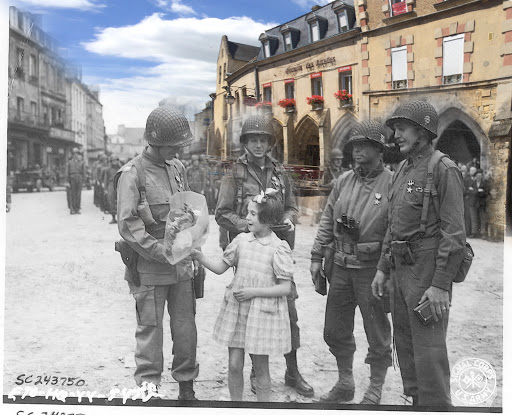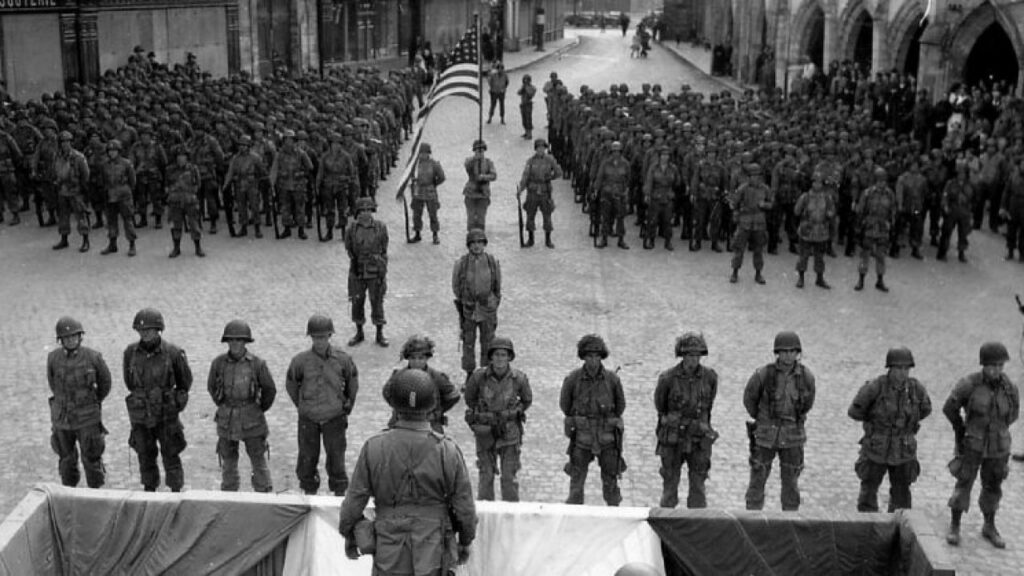- This topic has 2 replies, 1 voice, and was last updated 4 years, 11 months ago by
 GrimTeK_303.
GrimTeK_303.
- You must be logged in to reply to this topic.
The Battle of Carentan was an engagement in World War II between airborne forces of the United States Army and the German Wehrmacht during the Battle of Normandy. The battle took place between 6 and 13 June 1944, on the approaches to and within the town of Carentan, France.
The objective of the attacking American forces was consolidation of the U.S. beachheads (Utah Beach and Omaha Beach) and establishment of a continuous defensive line against expected German counterattacks. The defending German force attempted to hold the town long enough to allow reinforcements en route from the south to arrive, prevent or delay the merging of the lodgments, and keep the U.S. First Army from launching an attack towards Lessay-Périers that would cut off the Cotentin Peninsula.

Carentan was defended by two battalions of Fallschirmjäger-Regiment 6 (6th Parachute Regiment) of the 2nd Fallschirmjäger-Division and two Ost battalions. The 17th SS Panzergrenadier Division, ordered to reinforce Carentan, was delayed by transport shortages and attacks by Allied aircraft. The attacking 101st Airborne Division, landed by parachute on 6 June as part of the American airborne landings in Normandy, was ordered to seize Carentan.
In the ensuing battle, the 101st forced passage across the causeway into Carentan on 10 and 11 June. A lack of ammunition forced the German forces to withdraw on 12 June. The 17th SS PzG Division counter-attacked the 101st Airborne on 13 June. Initially successful, its attack was thrown back by Combat Command A (CCA) of the U.S. 2nd Armored Division.
On 6 June 1944, the Allies launched a massive and long-anticipated air and amphibious invasion of Normandy, codenamed Operation Overlord.[2] The 101st Airborne Division paratroopers landed behind Utah Beach with the objective of blocking German reinforcements from attacking the flank of the U.S. VII Corps during its primary mission of seizing the port of Cherbourg. The glider troopers landed by glider and ships on 6 and 7 June.
Merging the American beachheads at Utah and Omaha Beach was a D-Day objective of the amphibious forces but was not achieved because of heavy German resistance at Omaha. Moreover, Allied intelligence believed that three German divisions were massing to drive a wedge between them. Supreme Allied Commander General Dwight D. Eisenhower inspected Omaha on 7 June and ordered a “concentrated effort” to make the linkup.

Lieutenant General Omar Bradley, senior American ground commander, ordered the original tactical plan be changed to make the top priority of U.S. operations the joining of the lodgments through Isigny and Carentan. VII Corps received the Carentan assignment and assigned the 101st Airborne Division, closest to the city, “the sole task of capturing Carentan.”
Carentan is a port city located in Normandy, France, in the Douve River valley at the base of the Cotentin Peninsula. At the time of the Second World War, Carentan’s civilian population was about four thousand.[1] Four major highways and a railroad converged in the city, from Cherbourg to the northwest, Bayeux and Caen to the east, Saint-Lô to the southeast, and Coutances to the southwest.[5] The city is dominated by high ground to the southwest and southeast, all of which was under German control during the battle. Its other three approaches are bordered by watercourses: the Douve River to the west and north, a boat basin to the northeast, and the Vire-Taute Canal to the east. The Germans flooded much of the Douve River floodplain prior to the invasion, resulting in a marshland impassable to vehicles and difficult to cross by infantry, a tactic once used by Napoleon Bonaparte at the same location.

The highway from Saint Côme-du-Mont crossed the floodplain via a narrow 1 mile (2 km) long causeway having banks rising six to nine feet (2–3 m) above the marsh. Four bridges spanned the Douve and several tributaries along the causeway. Troops in the open under fire could find cover only by digging in on the sloping eastern bank of the causeway.[3] In retreating from Saint Côme-du-Mont, the Germans had blown up Bridge No. 2 on the causeway and a portion of the railroad embankment as well.[7]
Carentan was defended by two battalions of Fallschirmjäger-Regiment 6 (6th Parachute Regiment) of the 2nd Fallschirmjäger-Division, commanded by Oberst Friedrich von der Heydte, and remnants of 91 Air Landing Division‘s Grenadier-Regiment 1058. Both had escaped from nearby Saint Côme-du-Mont on 8 June when the village was captured by the 101st Airborne Division. II./FJR6 and III./FJR6 (2nd and 3rd Battalions, 6th Parachute Regiment) were still intact as fighting formations, but III./GR1058 had been nearly destroyed in three days of combat and was no longer effective as a unit.

The German LXXXIV Corps (84.Korps) reinforced the 6th Parachute Regiment (FJR6) with two Ost battalions and a few survivors of Grenadier-Regiment 914 (German 352nd Infantry Division) following its 9 June defeat at Isigny. Army Group B commander Field Marshal Erwin Rommel ordered von der Heydte to defend the town “to the last man.”[6] Otl. von der Heydte positioned the third- and fourth-rate (by German definition) Ost battalions along the Vire-Taute Canal to defend to the east. II./FJR6 he placed across the Carentan end of the causeway, and III./FJR6 dug in to defend against an attack from the north.
The 17th SS Panzergrenadier Division stationed at Thouars, ostensibly a mechanized infantry division of the OKW Mobile Reserve but without tanks or adequate transport, was ordered on 7 June to move to Normandy following the Allied landings. However it was delayed by shortages of trucks and attacks by Allied aircraft that destroyed bridges over the Loire River and interdicted rail movements. Advance elements reached Angers on 9 June and Saint-Lô on 10 June, by which time Rommel’s main concern was in preventing an attack westward from Carentan to cut off the Cotentin. The 38th Panzergrenadier Regiment formed a mobile battle group to resist V Corps units south of Isigny, and the 37th PzG-Rgt was sent to Carentan.
The 101st Airborne Division consolidated its forces in Normandy on 9 June. Its three parachute regiments (501st, 502nd, and 506th PIRs) had been badly scattered during their air drops, losing a significant number of men killed and missing as a result, and had suffered further casualties in taking Saint Côme-du-Mont. Its 327th Glider Infantry Regiment had landed largely at Utah Beach on D+1 (7 June) and except for its third battalion (the attached 1st Battalion, 401st GIR), had yet to engage in serious combat. Several units of the 327 did land by ship on D-Day. The 327 HQ Co Anti-Tank Platoon glided into France.
The 2nd Armored Division, part of the U.S. V Corps, had advanced off Omaha Beach to support the drive of the 175th Infantry Regiment (29th Division) to Isigny. Its Combat Command A (CCA), consisting of M4 Sherman tanks of the 2nd Battalion, 66th Armored Regiment and mechanized infantry of the 3rd Battalion, 41st Armored Infantry Regiment, was available as an armored force reserve for the 101st Airborne.[8]
On 9 June the 101st finished consolidating, with the 502nd PIR guarding the right flank along the upper Douve River, the 506th PIR deployed across the Carentan highway, and the 327th GIR on the left in positions along the Douve River opposite Brévands.The 501st PIR was the division’s reserve and guarding the left flank east of the 327.

Patrols and aerial reconnaissance of Carentan indicated that the town might be lightly defended, and a plan to capture the city by a double envelopment was contrived, using the 502nd PIR on the right and the 327th GIR on the left, scheduled to jump off just after midnight 10 June. The 502nd’s mission was to force the bridges and capture high ground southwest of the town along the Périers highway (Hill 30) to block withdrawal. The 327th was to cross the Douve at Brévands, circle a mile to the east, and come in on the road west from Isigny to take the town.

Source: Wikipedia , Band of Brothers